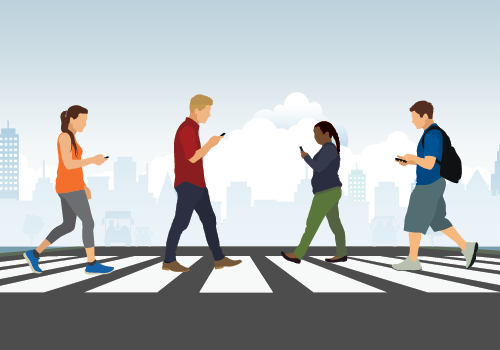
Distracted walking injuries involving cell phones accounted for an estimated 11,101 injuries between 2000 and 2011.
This article is from the Spring 2016 issue of The Quill. To view the full issue, visit The Quill archive.
In our world of instant gratification,
it’s becoming more and more prevalent for us to be distracted by our cell phones or other electronic devices. Many people no longer keep cell phones in their pockets or purses. Most people hold their phones in their hands to get their news as soon as possible. Did you know that 91% of the U.S. population now owns a cell phone? Per a report from Digital Trends in June 2015, Americans spend 4.7 hours a day on their smartphones. The average American is awake for just over 15 hours a day, which means we spend about a third of our time each day on our phones, and we are likely not sitting or standing still in a safe place for that entire duration.
A professor at William Paterson University conducted a study of more than 21,000 pedestrians at five of the most dangerous intersections in Manhattan and found that nearly half of pedestrians crossing on a “DON’T WALK” signal and about one-third crossing on a “WALK” signal were distracted. These pedestrians were wearing headphones, talking and/or looking down at an electronic device. The American Academy of Orthopedic Surgeons (AAOS) refers to these distracted pedestrians as “Digital Deadwalkers.” Per the AAOS, more and more pedestrians fall down stairs, trip over curbs or other objects and step into traffic each year, causing injury and even death.
According to health and safety publication EHS Today, distracted walking injuries involving cell phones accounted for an estimated 11,101 injuries between 2000 and 2011, making it a “significant safety threat.” The trend is so alarming that it was included for the first time in the annual National Safety Council statistical report “Injury Facts,” which tracks the leading causes of unintentional injuries and deaths. In 2010, more than 4,000 pedestrians were killed and another 70,000 were injured in traffic crashes, with distraction potentially playing a contributing role. According to the National Highway Traffic Safety Administration, pedestrian injuries reached 78,000 in 2012, the highest number since 2001. Taking these facts into consideration, motor carriers should train drivers to be aware of distracted pedestrians and how to gain their attention to avoid striking them.
In an effort to reduce the number of injuries and deaths associated with distracted walking, a few states have experimented with imposing fines for texting in dangerous walking situations. In New York City, speed limits have been lowered in part to make traffic less dangerous for pedestrians.
A Stony Brook University study in 2011 documented the effect of texting on navigation while walking. The study found that it is significantly more dangerous to text than to talk on a cell phone, leading to a 61% rate of navigation errors. Typing (texting) or reading a text alters a pedestrian’s gait, speed and walking pattern.
Here are a few safety tips from the AAOS to help keep you safe and alert while walking:
- If you must use headphones or other electronic devices, keep the volume at a low level so you can still hear the sounds of traffic and your surroundings.
- While you walk, focus on the people, objects and obstacles around you.
- Do not jaywalk. Cross the street carefully at designated crosswalks, paying attention to the pedestrian traffic flow and the vehicles or bicycles in or near the road.
- If you need to do something that could distract you (i.e., speaking to a child or the person next to you, taking/making a phone call or sending an email/text), do so in a safe area away from the pedestrian traffic flow.
Never assume that others nearby are aware of you, even if you are walking with a large group of people. If you have the right-of-way while crossing a street, do not assume that drivers, cyclists or even other pedestrians walking next to you are aware of you. Look up and pay attention—they may be distracted themselves. While FOMO (fear of missing out) is very real for some people who feel a constant need to be digitally connected, do not forget that there is a whole world of physical activity happening around you. Do not allow distractions to compromise your safety.